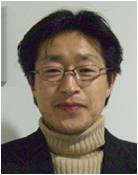Faculty
Yusuke Matsuda
Major research fields
 Plant Moleculan, Physiology, Signal Transduction
Plant Moleculan, Physiology, Signal Transduction
Marine diatoms are the most successful group of algae which is responsible for about one fifth of global CO2 fixation. This fact was discovered recently and now the diatom is one of the emerging model organisms. They have a complex evolutionary history based upon multiple symbiosis, a very unique mode of cell division, and an extremely efficient productivity with redundantly duplicated cellular metabolisms. As another intriguing feature of diatoms, they self-assemble intricately structured silica-based cell walls, which exhibit an amazing variety of shapes and patterns and are believed to be one of bases of future nanotechnology. Furthermore, it is believed that ancient diatom biomass was a major contributor to fossil fuels due to their massive oil producing capacity. These characteristics in diatom metabolism are now expected to be utilized as a source for carbon-neutral fuels for the future. Main research topics in our laboratory are divided into the following three: i) Molecular mechanisms of marine diatoms to take up and concentrate inorganic carbon efficiently from seawater; ii) Mechanisms of marine diatoms to sense and respond to changes in environmental factors such as CO2, iron, temperature, and pH; iii) Mechanism of biomineralization of silicate by peptides. We also study about the development of new molecular biological tools of marine diatoms and silica- based nanomaterials.
Major relevant publications
- Naoki Ohno, Takuya Inoue, Ryosuke Yamashiki, Kensuke Nakajima, Yuhei Kitahara, Mikiko Ishibashi, and Yusuke Matsuda (2012) CO2-cAMP responsive cis-elements targeted by a transcription factor with CREB/ATF-like basic zipper domain in the marine diatom, Phaeodactylum tricornutum. Plant Physiol., 158: 499-513
- Sae Kikutani, Rie Tanaka, Yukiko Yamazaki, Satoshi Hara, Toru Hisabori, Peter G Kroth, Yusuke Matsuda (2012) Redox regulation of carbonic anhydrases via thioredoxin in the chloroplast of the marine diatom, Phaeodactylum tricornutum. J Biol Chem 287: 20689-20700
- Kensuke Nakajima, Atsuko Tanaka, Yusuke Matsuda (2013) SLC4 family transporters in a marine diatom directly pump bicarbonate from seawater, Proc Natl Acad Sci USA 110(5): 1767-1772
- Yusuke Matsuda, Peter G. Kroth (2014) Carbon fixation in diatoms. In Martin Hofmann-Marriott Ed. The Structural Basis of Biological Energy Generation, Advances in Photosynthesis and Respiration, The Structural Basis of Biological Energy Generation Volume 39, Chapter 18, 2014, pp 335-362, Martin Hohmann-Marriott Ed. Springer, DOI: 10.1007/978-94-017-8742-0_18
- Mio Samukawa, Chen Shen, Brian M. Hopkinson, and Yusuke Matsuda (2014) Localization of putative carbonic anhydrases in the marine diatom, Thalassiosira pseudonana. Photosynthesis Research 121: 235-249



